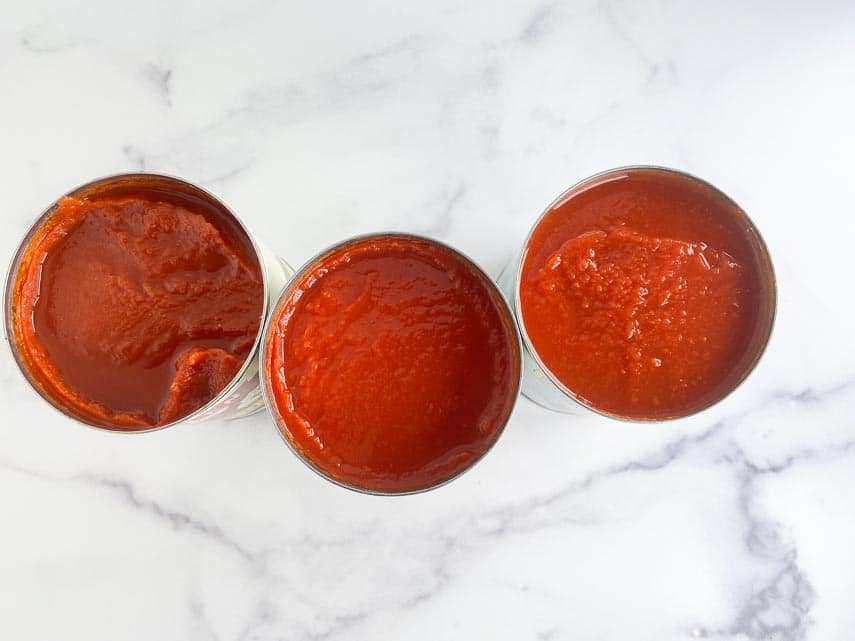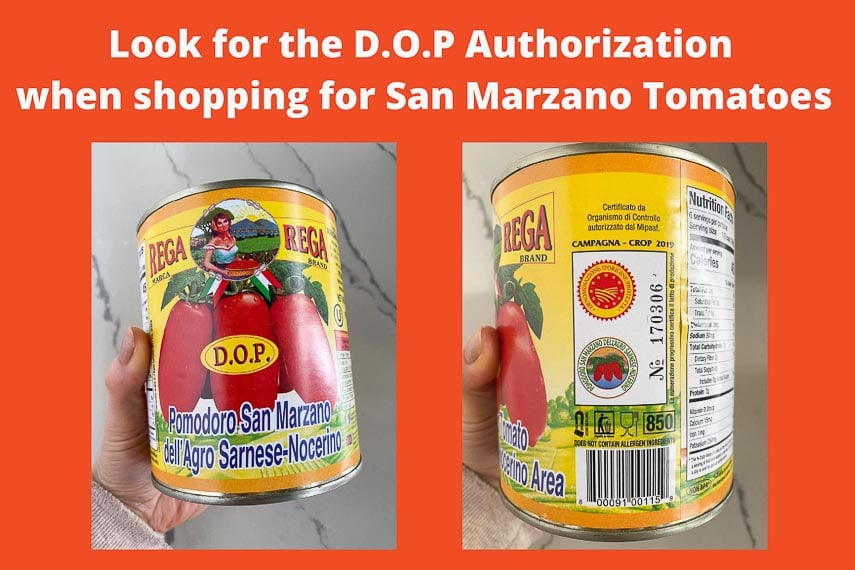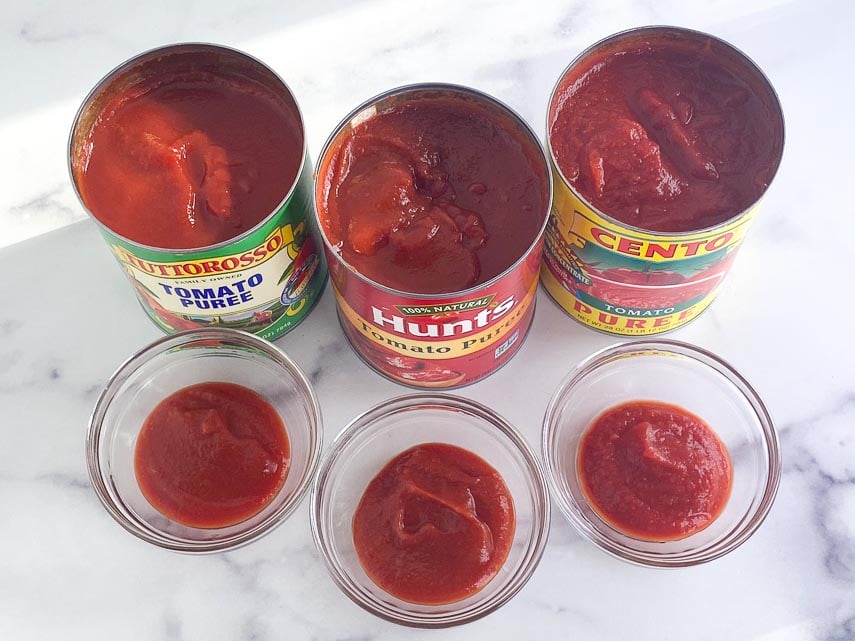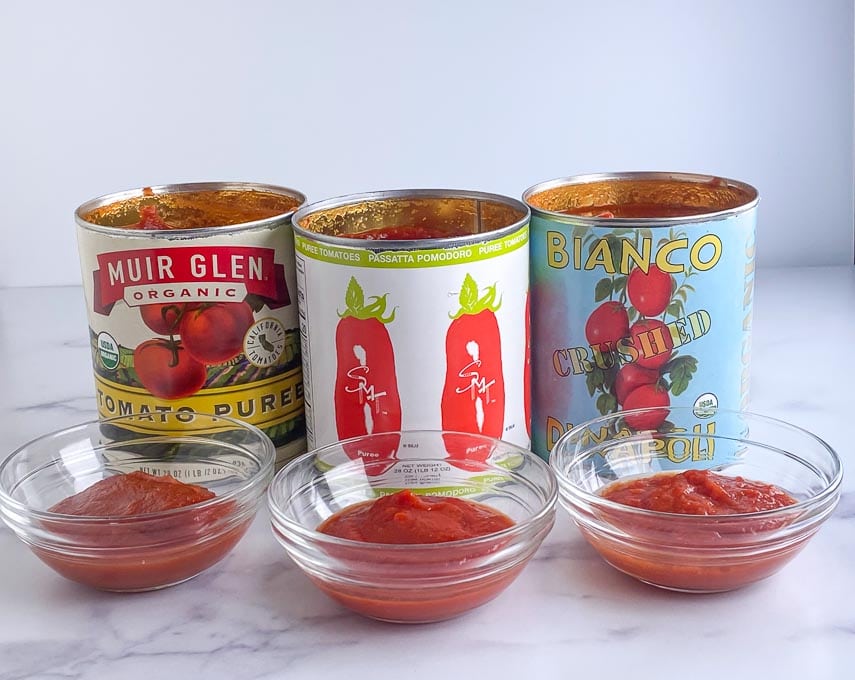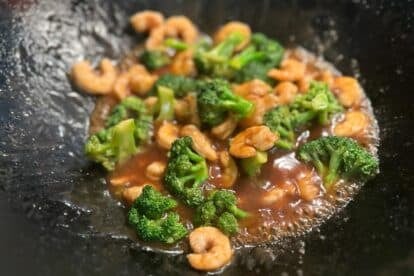Our Low FODMAP Pizza Sauce takes about 5 minutes to make and features canned tomatoes, a little dried basil and oregano, and FreeFod Garlic Replacer. Stir them all together and you are done. (I do also suggest that you read Everything You Need To Know About Low FODMAP Pizza as well as Low FODMAP Pizza Ingredients & Equipment).
That is really all you need to know! If you are a die-hard pizza lover and want more info on whether pizza sauce is cooked or uncooked, about choosing canned tomatoes, what San Marzano tomatoes are and how to find them, read on, otherwise, jump to the recipe.
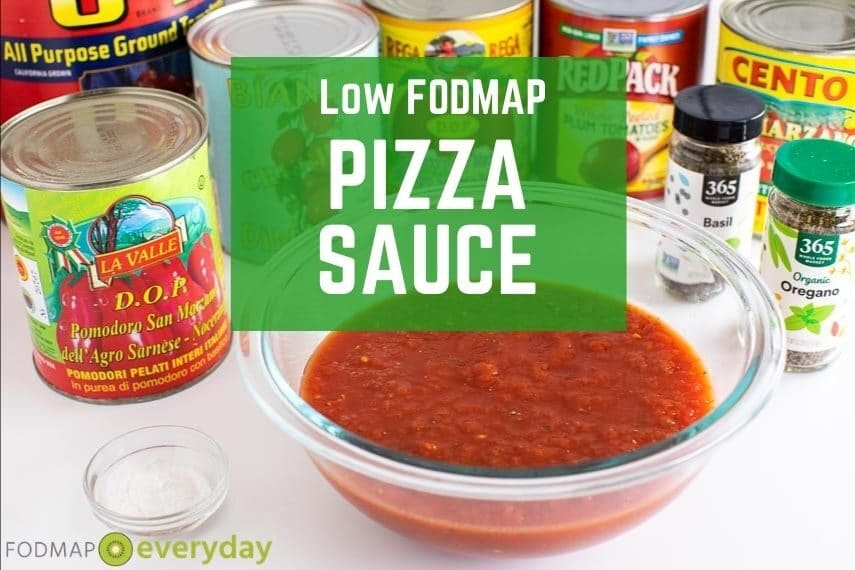
Pizza Sauce vs. Marinara Sauce
The following section details the finer – but important – points of pizza sauce. Pizza Sauce is not marinara. It is not pasta sauce. It has a different usage and therefore is made differently.
Jump to the recipe if you like, but you are about to acquire knowledge that is going to help you make better Pizza Sauce, and therefore better pizza.
Pizza sauce, traditionally speaking, is a canned tomato-based sauce that is quite simple to prepare and often contains very few ingredients (although various chefs have their favorite approaches). It is meant to play a synergistic role, along with fantastic dough and just the right amount and kind of cheese. That said, a pizza with a poor sauce can never be a truly great pizza; or at the very least, it will remain a pizza that has not attained its potential brilliance.
I could write a treatise just on this topic alone, and yes, I know you can find “pizza sauce” recipes all over the Internet that are cooked. But if you take a deep dive into the parts of the web where true pizzaiolo and pizzaiola (pizza makers) discuss the finer points of pizza making, you will find a clear divide: pizza sauce is uncooked. Cooked sauce goes on pasta.
First of all, I put “uncooked” in quotes because the canned tomatoes, by their very definition, are cooked – and you do use canned tomatoes (more on that later). It is uncooked because it doesn’t need to be cooked any further. You are starting with canned tomatoes, which have gone through a cooking process, and then the sauce will cook again on the pizza, classically in very hot ovens. It doesn’t need to be cooked a third time.
Now, getting back to the pizza forums on the web, if you are interested and really want to delve into this, I suggest reading the sauce threads at PizzaMaking.com. There is A LOT to digest. The cooked vs. uncooked thread alone has over 300 entries.
Dried herbs are used in our Low FODMAP Pizza Sauce. If you go to the aforementioned pizza forum and dive in, you will see that some folks take a blended approach, and while they don’t cook their pizza sauce, they believe the dried herbs needs some help via heat. Here is a discussion about releasing the inherent flavors of dried oregano properly, posted by registered pizza forum user ,“November”, back in 2006:
“The technique, known in the industrial chemical engineering world as Microwave-Assisted Extraction (MAE), is more effective than simple heating though. The following is a more detailed description of the cytoplasmic eruption as described by Girija Raman and Vilas G. Gaikar of the Department of Chemical Technology, University of Mumbai.
‘Studies have revealed that dielectric heating of the polar cellular matrix resulted in remarkable swelling and coalescence of the oil cells and other constituents. The resulting pressure, built-up within the cell, breaks open the cell, releasing the constituents and providing easy access for solvent penetration (water in this case) […] During the microwave treatment, membranes of oil droplets rupture and the oil accumulates near the cell wall. The protein structures also agglomerate into larger particles. When the power level is low, this coalescence takes place over a longer period of time, but at higher power levels, the confluencing of smaller lipid bodies into larger agglomerates occurs at an early stage of heating, leading to a rapid cell rupture and an increased rate of extraction.’”
I told you they get into it. What November is basically saying is, nuke your dried herbs in a little water, to extract maximum flavor – if you like. Not everyone does this. Go to the thread to read more about the math of calculating the power of your microwave, ratio of water, to herb, to time.
Ah, another question that could be discussed to an nth degree. Go back to that pizza forum and read more than you ever thought you wanted or needed to know. The short answer is the ones that you like.
We brought over 12 different kinds of canned tomatoes into the FODMAP Everyday® Test Kitchen. They do vary from one another in flavor, balance, texture and color.
There are a few things that we considered and one of them was whether San Marzano tomatoes were the best for our purposes. The recommendation for San Marzano tomatoes comes up frequently with pizza experts, so we had to address it.
You can see below that the 3 brands below even look different in the can. The Muir Glen Purée on the left is the thickest of this line up. The purée/passatta from the “San Marzano” brand in the middle is the thinnest and most sauce-like. The crushed version of the Bianco DiNapoli brand on the right have the most “crushed” texture of these three.
The San Marzano tomato designation signifies both a particular type of plum tomato as well as the fact that it is grown in a very specific region of Italy – the Agro Sarnese Nocerino of the Sarno River valley near Mount Vesuvius. The volcanic soil and microclimate greatly affect how the tomatoes taste, which is why they cannot be grown anywhere else (more on that below).
The type – the San Marzano – looks like a plum, or Roma, tomato, but is actually structurally different. It has very thick inner walls and very few seeds. It is very meaty and pulpy, with an elongated shape and a will often sport a tip at its bottom end.
The terroir of the region creates a tomato like no other. They are special enough to have earned the official D.O.P designation (Denominazione d’Origine Protteta), which signifies that they are a “protected designation of origin”. Other foods like Parmigiano Reggiano and Prosciutto are similarly protected.
A true San Marzano tomato will be that specific kind of tomato and grown in that specific place.
So, how come there are tomatoes labeled as San Marzano that hail from California? Well, according to some studies, a mere 5% of the “San Marzano” tomatoes labeled as such in the U.S. are true San Marzano. Counterfeits abound. One problem is that if a U.S. purveyor slaps a D.O.P. designation on an American product, there is no regulatory body here in the U.S. monitoring this. These imposters have been called the “fake Rolex of canned foods).
Some “fakes” taste great, so that isn’t the main point. If you are going to pay for San Marzano tomatoes, and they will cost more than most, you should at least know what you are buying.
Overall, they tend to be sweet (less acidic) and rich in flavor, and meaty in texture. They are quite balanced in their sweetness and acidity, and many say have a “tomato-iness” that is unparalleled.
Not necessarily. It depends on your tastebuds. They do not always come out on top in taste tests.
But, there are situations, such as when making true Neapolitan pizza, when you must use San Marzano tomatoes, according to the Associazione Verace Pizza Napoletana. And of course you have to be in Naples, but I digress.
Luckily, there are some easy to see “tells” that will alert you to whether a San Marzano product is authentic, or not:
● The tomatoes will be whole or cut in half (sometimes referred to as fillets). They will never be diced, crushed, puréed etc.
● San Marzano canned tomatoes will be peeled.
● True San Marzano tomatoes will always be in cans. No bottles or boxes.
● The words Pomodoro San Marzano dell’Agro Sarnese Nocerino must be on the label.
● Look for the official D.O.P. certification symbol, which will have the words, Denominazione d’Origine Protteta.
● There should also be a certification number on the can.
● They will not contain any calcium chloride, which is found in many tomatoes canned in the U.S. It helps tomatoes keep their shape, which can be useful for diced shapes, but it also retards them from breaking down into a sauce.
This does get confusing. The can says “San Marzano” and also says “Certified”, but they are not certified by the Cosorzio San Marzano. Here is the information directly from the Cento website:
“Cento is the only United States brand that has its production facility in the Sarnese Nocerino area of Italy, literally in the shadow of Mount Vesuvius. The rich volcanic soil, high water table and ideal Mediterranean microclimate all combine to make San Marzano tomatoes the premier choice for any recipe.”
So, they are the San Marzano type of tomato, and they are grown in the “right” area, but they are certified by an independent third-party agency, Agri-Cert.
In the image below you can see the the Tuttorosso on the left is a smooth, thick purée. The Hunt’s in the middle is even thicker, but also so smooth that it lacks texture; its is almost paste-like. The Cento have more of a crushed tomato texture, even though it is called “purée”.
If you are using whole tomatoes, know that they are not created equal. Some are San Marzano, as discussed above. Some are salted, some are not. Some contain calcium chloride, others do not.
But what I want to call your attention to is that some are packed in juice and some are packed in purée and that fact can make a huge difference in a recipe. Know what you are buying and what a recipe is calling for.
The tomatoes themselves can be different varieties. They are grown in different conditions, harvested and prepared in different ways. Some are “steam-peeled” and some have been dipped in a lye bath to aid peeling (it is safe to eat). As mentioned before, some are packed in juice, others in purée. Some brands add salt and/or citric acid or calcium chloride. All of these things affect flavor, color and texture.
Because when it comes to our Low FODMAP Pizza Sauce, there are very few ingredients and the canned tomatoes are primary. If we start with a substandard canned tomato product, our sauce will not be optimum.
I look at this from two perspectives: you can start with crushed or puréed tomatoes (more on that in a moment) or you can start with whole San Marzanos. Depending on which way you go, there will be a different preparation technique.
For whole peeled, I often turn to authentic D.O.P certified San Marzanos, such as the Rega San Marzano and La Valle San Marzano. I also like the Bianco DiNapoli whole tomatoes.
If I am using crushed and/or a purée I will sometimes use an import, other times a domestic product. I do like Bianco DiNapoli crushed, RedPack (also called Red Gold), San Marzano brand and Muir Glen Crushed – and Muir Glen and Cento Purée.
If you have access to a wholesaler or restaurant supplier, you might look into brands that some chefs swear by such as Stanislaus Alta Cucina and Valoroso; Miracolo di San Gennaro Plum Tomatoes; and Gustarosso San Marzano Tomatoes.
If you are in the U.S. you might have seen this product shown below in the center with the graphic white label sporting red tomatoes and green and white lettering. It says right there, “San Marzano” tomatoes. They are not a true San Marzano product. They contain calcium chloride. They come in crushed, diced, puréed etc.
The brand is simply named after the famed tomatoes, which is legal to do in the U.S. They don’t even try to fake a DOP label; using the name is enough to confuse shoppers. Some folks love them. That’s fine, just know what you are buying.
Many canned tomato products, especially those imported from Italy, do contain some basil. Some of them rate very well in taste testings. Obviously when cooking Italian food this is not necessarily an impediment, but if you are using your canned tomatoes for Indian cooking, for instance, you might not want that flavor there. As always, read your labels and know what you are buying.
In theory, in an ideal world, crushed tomatoes are a coarser preparation than a purée, which is smoother and thicker in a more sauce-like way. The problem is that when you open up can after can of crushed tomatoes and puréed tomatoes, you will notice that in some cases there is not much of a difference between what is called crushed and what is called puréed.
What Is A Food Mill?
You will see in the recipe below that I call for a food mill fitted with a coarse screen. If you start with whole tomatoes, you have to break them down somehow. Some folks use a blender or immersion blender – and you can – but the danger is breaking down the tomatoes too much. Too much blending can rupture the cell walls of the tomatoes in such a way as to render your sauce somewhat watery. Even if it looks okay raw, it might water-out during baking.

The food mill is a gentle way of breaking down the tomatoes and even has the added bonus of holding back skin and most of the seeds, so that you can discard them easily.
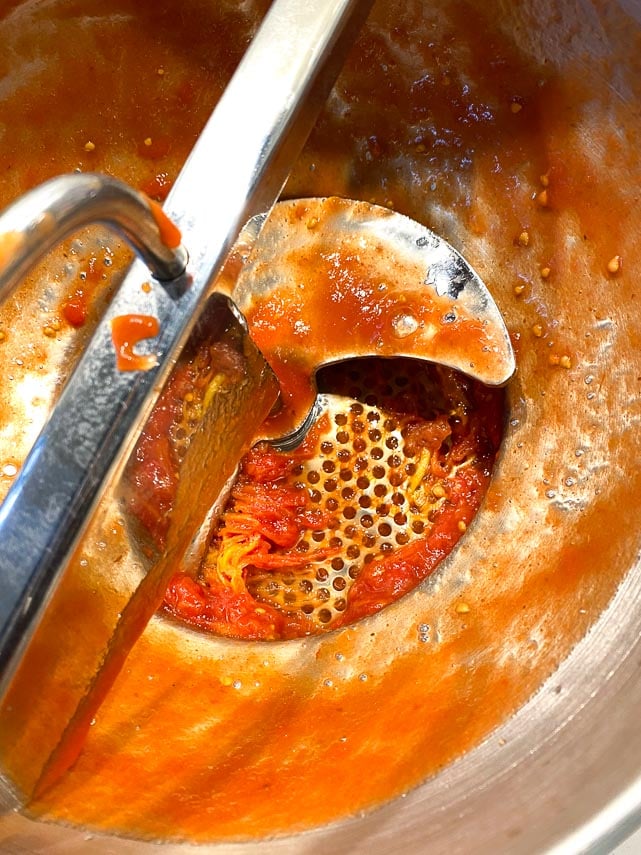
You are left with a perfectly textured pizza sauce. If you want to use a blender, just proceed very carefully and do not over-blend, which will leave you with watery sauce.
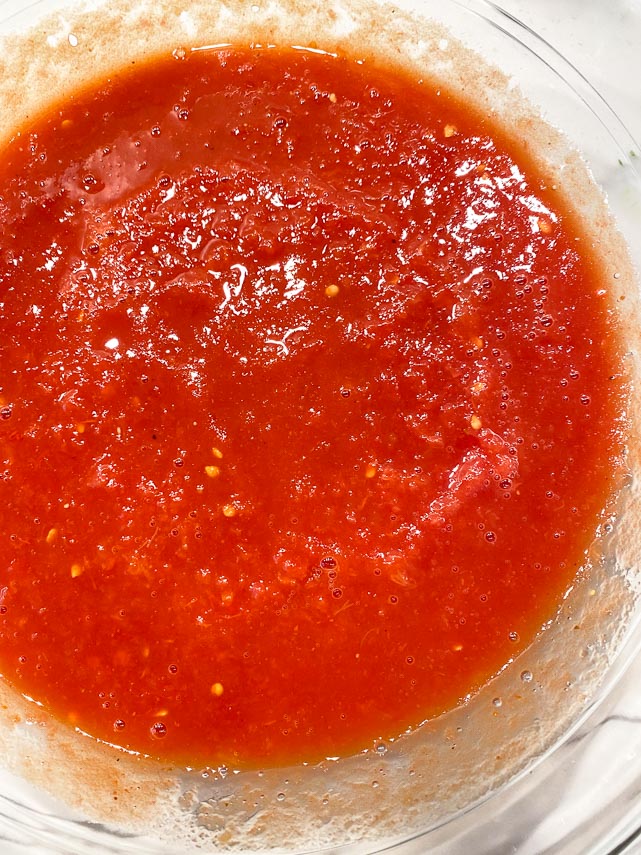
Do I Have To Use The FreeFod Garlic Replacer?
If you want pretty true-to-form garlic flavor, and want to keep this recipe low FODMAP, I say yes. You can purchase it via Amazon.
Are There Any Replacements For The FreeFod Garlic Replacer?
Sure, there are replacements, but they are not the same. Smoke ‘n Sanity Essence of Garlic has a good garlic flavor, but also contains salt, which may or may not be desirable for you. You could add a little Low FODMAP Garlic-Infused Oil, made with olive oil, but that is adding fat where you don’t necessarily need it. Gourmend Garlic Scape Powder is mild and can add a bit of garlicky flavor.
Why Is There No Salt Or Pepper In The Pizza Sauce?
Because I don’t think it needs them. Of course, it also depends on the tomatoes you use, as some have salt added, some don’t, and some have more added than other brands. Season to taste, but remember, this is not spaghetti sauce or a marinara. It should taste clean and simple – like tomatoes.
Can I Make This Ahead?
You can. In fact, some folks think refrigerating overnight will allow flavors to develop. Then there are those who believe refrigerating tomato sauce mutes its flavor. My opinion is that most people’s palates will be fine either way.
My preference is to make it early in the day that I am going to use it and I leave it out at room temperature.
Ingredients
Choose your canned tomato product, then make sure your dried herbs are “fresh”. Even dried herbs can be old and lackluster. Buy high quality dried herbs and store in a dark cool place – not over the stove!
We do think the FreeFod Garlic Replacer adds loads of flavor to this pizza sauce.
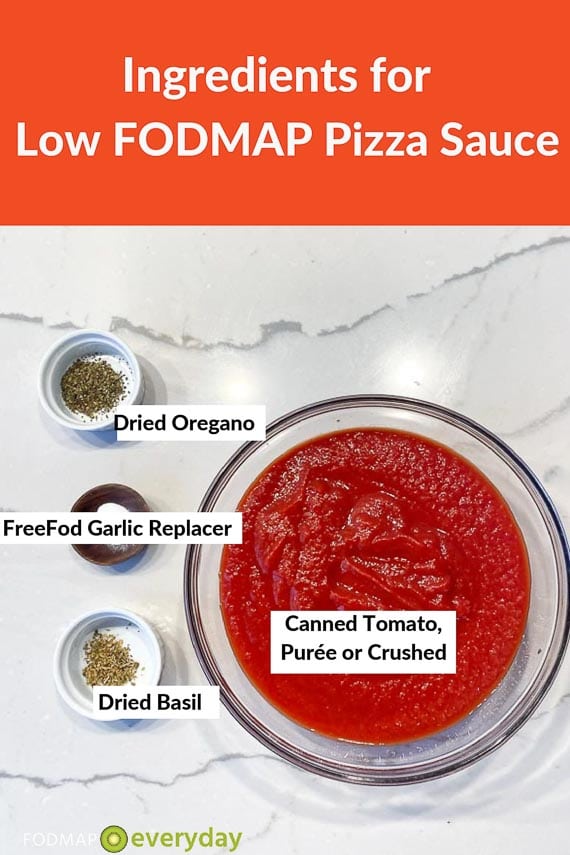
How To Make Pizza Sauce
Couldn’t be easier. Stir those ingredients together!
I do like to crush the herbs between my fingers to release flavor.
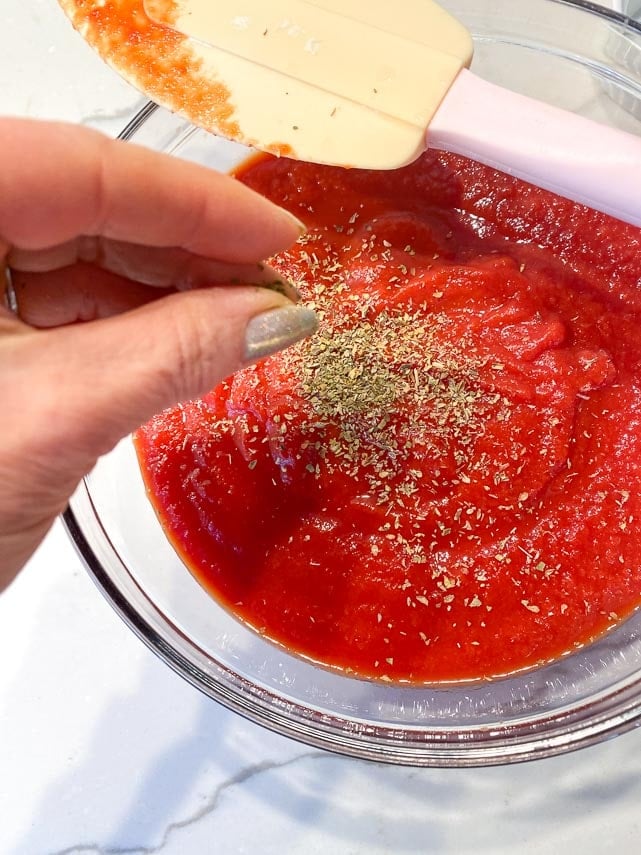
Then add your FreeFod Garlic Replacer, stir together, and you are done.
How To Use Pizza Sauce
This sauce is for most of our pizza recipes. Some use a different sauce, so please follow the instructions in individual recipes. This is not meant to be a pasta sauce. If you want an easy cooked sauce, check out our Everyday Quick Tomato Sauce.
aUse this sauce with our:
- Easy Low FODMAP Pizza
- Low FODMAP Pizza 2.0
- Low FODMAP Sourdough Pizza made with our Low FODMAP Sourdough Starter
- 72-Hour Ferment Low FODMAP Pizza Made
- Wood-Fired Neapolitan-Style Low FODMAP Pizza
FODMAP Information
Our recipes are based on Monash University and FODMAP Friendly science.
- Canned Tomatoes: Monash University has lab tested canned tomatoes and they are low FODMAP at 92 g or 3.2-ounces, which they say is about ⅗ of a cup. Moderate FODMAPs kick in at about ¾ cup or 115 g, at which point fructose can become an issue.
- Tomatoes: Both Monash University and FODMAP Friendly have lab tested common, beefsteak tomatoes. Monash University lab tests have shown no FODMAPs. FODMAP Friendly gives them a “Pass” at ½ cup (75 g) portions. Cherry tomatoes and Plum (Roma) tomatoes have also been tested by Monash and FODMAP Friendly. Both Monash and FODMAP Friendly recommend 75 g of cherry tomatoes as a serving (about 5 or ½ cup) and 75 g of plum or Roma tomatoes, which is about 1 small tomato or ½ cup.
Please always refer to the Monash University & FODMAP Friendly smartphone apps for the most up-to-date lab tested information. As always, your tolerance is what counts; please eat accordingly. The ultimate goal of the low FODMAP diet is to eat as broadly as possible, without triggering symptoms, for the healthiest microbiome.
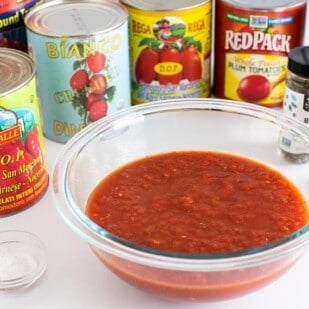
Low FODMAP Pizza Sauce
Our Low FODMAP Pizza Sauce takes about 5 minutes to make and features canned tomatoes, a little dried basil and oregano, and FreeFod Garlic Replacer. Stir them all together and you are done.
Low FODMAP Serving Size Info: Makes about 3 cups (720 ml); serving size approx. ¼ cup (60 ml); 12 servings
Ingredients:
- 1, 28- ounce (794 g) can of either whole peeled tomatoes in juice or purée, or puréed/crushed tomatoes
- ½ teaspoon dried basil
- ¼ teaspoon FreeFod Garlic Replacer
- ¼ teaspoon dried oregano
Preparation:
-
Using Whole Tomatoes Packed In Juice: Drain the juice and reserve. Pulse canned tomatoes briefly in blender or with immersion blender or press through a food mill fitted with a coarse screen (which is my preference as it will also remove stray peels and seeds). Add juice back in if needed for desired texture.
-
Using Whole Tomatoes In Purée: Pulse canned tomatoes with purée briefly in blender or with immersion blender or press through a food mill fitted with a coarse screen (which is my preference as it will also remove stray peels and seeds). Note that you can drain the purée and reserve it as mentioned above, but most pizza makers use everything in the can.
-
Using Purée or Crushed: These are ready to go right from the can.
-
Stir together you chosen tomato product, the basil, FreeFod Garlic Replacer and oregano. That’s it. You can use it right away, but I like to make it early in the day I am going to make pizza and allow it to sit at a cool room temperature.
-
You may refrigerate in an airtight container for up to 2 days. It will last longer but flavors begin to change. You could freeze it, but I think it gets watery and because it is so quick and easy to make, I highly suggest making when you need it.
Notes:
FODMAP Information
Our recipes are based on Monash University and FODMAP Friendly science.
- Canned Tomatoes: Monash University has lab tested canned tomatoes and they are low FODMAP at 92 g or 3.2-ounces, which they say is about ⅗ of a cup. Moderate FODMAPs kick in at about ¾ cup or 115 g, at which point fructose can become an issue.
Please always refer to the Monash University & FODMAP Friendly smartphone apps for the most up-to-date lab tested information. As always, your tolerance is what counts; please eat accordingly. The ultimate goal of the low FODMAP diet is to eat as broadly as possible, without triggering symptoms, for the healthiest microbiome.
Nutrition
All nutritional information is based on third-party calculations and should be considered estimates. Actual nutritional content will vary with brands used, measuring methods, portion sizes and more. For a more detailed explanation, please read our article Understanding The Nutrition Panel Within Our Recipes.
